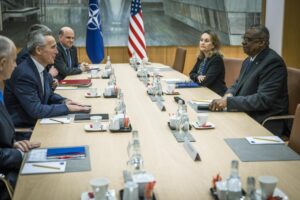Defense Secretary Lloyd Austin said the latest meeting of the Ukraine Defense Contact Group on Tuesday included a focus on new security assistance efforts among the group to bolster Kyiv’s capabilities ahead of a potential spring offensive operation.
“We’re going to continue to work with Ukraine to address Ukraine’s most pressing needs. Again, they’re contemplating an offensive in the spring and that’s just weeks away. And so, we have a lot to get done. So if you think about the number of systems that we’re bringing together, Bradleys, Strykers, Marder [infantry fighting vehicles], CV-90 [combat vehicles], [M]113 [armored personnel carriers], artillery and the list goes on and on. It’s a monumental task to get all those systems together, get the [Ukrainian] troops trained on those platforms and make sure that we have sustainment for all of those systems and get those systems into the fight. So that was really the focus of our conversation today.” Austin said during a press briefing following the meeting.

Tuesday’s meeting in Brussels was the ninth gathering of the U.S.-led Ukraine Defense Contact Group, with defense officials from 54 countries discussing ongoing efforts to assist Kyiv in its fight against Russia’s ongoing invasion.
“Because of [the potential spring offensive], we, all the partners in the Ukraine Defense Contact Group, have been working hard to ensure that they have the armored capability, the fires [and] the sustainment to be able to be effective in creating the effects on the battlefield that they want to create,” Austin said.
While the U.S. did not have a new weapons aid package to announce on Tuesday, Austin noted “significant” new donations detailed at the meeting, to include Italy and France jointly providing the SAMP/T air defense system built by EUROSAM and France working with Australia to ramp up production of 155mm ammunition to support Ukraine.
Austin noted Norway also announced a “very significant commitment” to provide just over $8 billion in military and civilian assistance to Ukraine over the next five years.
Army Gen. Mark Milley, chairman of the Joint Chiefs of Staff, during the press briefing also said 11 countries have now pledged to provide tanks for Ukraine, 22 have offered infantry fighting vehicles, 16 have donated artillery and munitions and nine more are providing air defense artillery.
Austin added that the Ukraine Defense Contract Group has collectively provided Ukraine with equipment equal to eight combat brigades’ worth of capability, to include the U.S.’ Strykers, Bradleys and Abrams, the U.K.’s Challenger tanks, Canada’s Senator armored personnel carriers, the refurbished T-72 tanks that the U.S., the Netherlands and Czech Republic are donating, Poland’s latest donation of T-72 tanks as well as Germany, Poland, Canada, Portugal, Spain, Norway, Denmark and the Netherlands move to provide Leopard battle tanks.
“Together, we have made clear we will support Ukraine’s self defense for the long haul and we will move out with the urgency that the moment demands,” Austin said. “All of these capabilities will continue to be important for Ukraine’s success on the battlefield. But as I said last month at Ramstein [Air Base in Germany], this isn’t about one single capability. It’s about delivering all of the capabilities that we promised. It’s about integrating all these systems together. It’s about working with the Ukrainians to help them fight for their freedom.”
Austin was also asked about the rate that Ukraine is going through artillery ammunition provided by other countries, and said ongoing training to work with Ukrainian troops on maneuver operations may help bring that number down.
“We’re going to do everything we can, working with our international partners, to ensure that we get them as much ammunition as quickly as possible. And we’ll do everything we can to sustain our efforts there as well,” Austin said. “We are working with the Ukrainian soldiers in various places throughout Europe to emphasize additional training on maneuver. So as they place more emphasis on maneuver and shaping the battlefield with fires and then maneuvering, there’s a good chance that they’ll require less artillery munitions. But that’s left to be seen.”
Milley, when asked about the upcoming one-year anniversary of the start of the war, said he views Russia as having “lost” the conflict.
“In short, Russia has lost. They’ve lost strategically, operationally and tactically. And they are paying an enormous price on the battlefield. But until Putin ends his war of choice, the international community will continue to support Ukraine with the equipment and capabilities it needs to defend itself,” Milley said. “While Russia has waged this war for far too long, they will not outlast the Ukrainian people nor the group of allies and partners that met today.”